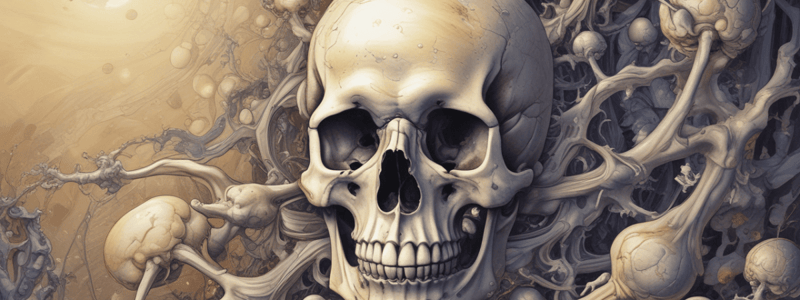Podcast
Questions and Answers
Chondroma is most commonly found in which part of the body?
Chondroma is most commonly found in which part of the body?
- Knee
- Vertebral column
- Pelvic bones (correct)
- Skull
What distinguishes osteosarcoma from osteoblastoma on X-ray imaging?
What distinguishes osteosarcoma from osteoblastoma on X-ray imaging?
- Destructive mixed blastic and lytic mass (correct)
- Polypoid growth with a mushroom-like appearance
- Central area (nidus) radiolucent with sclerotic rim
- Variably calcified and multilobular appearance
What histologic feature is characteristic of osteochondroma?
What histologic feature is characteristic of osteochondroma?
- Interlacing trabeculae of woven bone surrounded by osteoblasts
- Variable calcification and multilobular appearance
- Loose connective tissue stroma with giant cells
- Tons of osteoid (correct)
Which tumor shows a notable 'mushroom-like' appearance on X-ray imaging?
Which tumor shows a notable 'mushroom-like' appearance on X-ray imaging?
Aggressiveness of chondrosarcoma is determined by all of the following EXCEPT:
Aggressiveness of chondrosarcoma is determined by all of the following EXCEPT:
In Ewing sarcoma, which part of the bone is typically affected?
In Ewing sarcoma, which part of the bone is typically affected?
Which tumor has an ovoid shape with a long axis parallel to bone, a sclerotic margin, and a lobulated contour?
Which tumor has an ovoid shape with a long axis parallel to bone, a sclerotic margin, and a lobulated contour?
Which benign tumor can lead to generalized loss of bone density with endosteal resorption and expand into bone lesions?
Which benign tumor can lead to generalized loss of bone density with endosteal resorption and expand into bone lesions?
Which benign bone lesion originates from the calcaneus and does not require a biopsy?
Which benign bone lesion originates from the calcaneus and does not require a biopsy?
Which benign tumor may convert to chondrosarcoma in older patients and appears as a bubbly radiolucent lesion with calcifications?
Which benign tumor may convert to chondrosarcoma in older patients and appears as a bubbly radiolucent lesion with calcifications?
Which benign tumor presents as a bony projection from the bone surface resembling a mushroom cap?
Which benign tumor presents as a bony projection from the bone surface resembling a mushroom cap?
Which benign tumor shows an increased T2 signal and decreased T1 signal on imaging studies?
Which benign tumor shows an increased T2 signal and decreased T1 signal on imaging studies?
What is the notable thing about Fibrous Dysplasia?
What is the notable thing about Fibrous Dysplasia?
Which tumor can metastasize to the lungs or transform to fibrosarcoma or osteogenic sarcoma?
Which tumor can metastasize to the lungs or transform to fibrosarcoma or osteogenic sarcoma?
What is the characteristic feature of an Aneurysmal Bone Cyst?
What is the characteristic feature of an Aneurysmal Bone Cyst?
Which tumor has a CHICKEN WIRE appearance?
Which tumor has a CHICKEN WIRE appearance?
In which tumor do you find a Replacement of bone interior with fibro-osseous tissue?
In which tumor do you find a Replacement of bone interior with fibro-osseous tissue?
Which tumor shows an aggressive expansion and can lead to pain?
Which tumor shows an aggressive expansion and can lead to pain?
What is the characteristic appearance of Pigmented Villonodular Synovitis (PVNS) on MRI imaging?
What is the characteristic appearance of Pigmented Villonodular Synovitis (PVNS) on MRI imaging?
Which tumor/growth is characterized by having an appearance that resembles a coral reef on MRI imaging?
Which tumor/growth is characterized by having an appearance that resembles a coral reef on MRI imaging?
What is the age range commonly associated with Giant Cell Tumor of Tendon Sheath?
What is the age range commonly associated with Giant Cell Tumor of Tendon Sheath?
Which tumor/growth can cause joint pain, swelling, catching, locking, stiffness, or instability as symptoms?
Which tumor/growth can cause joint pain, swelling, catching, locking, stiffness, or instability as symptoms?
What distinguishes Neurilemmoma (Schwannoma) from other benign tumors based on its location?
What distinguishes Neurilemmoma (Schwannoma) from other benign tumors based on its location?
Which tumor/growth can erode bone and joint structures, leading to pain and swelling?
Which tumor/growth can erode bone and joint structures, leading to pain and swelling?
What distinguishes a mucoid cyst from other benign tumors?
What distinguishes a mucoid cyst from other benign tumors?
Which imaging feature is characteristic of a lipoma?
Which imaging feature is characteristic of a lipoma?
What differentiates fibroma from other benign tumors?
What differentiates fibroma from other benign tumors?
In which age group is pigmented villonodular synovitis (PVNS) most commonly seen?
In which age group is pigmented villonodular synovitis (PVNS) most commonly seen?
What is the primary symptom associated with a mucoid cyst?
What is the primary symptom associated with a mucoid cyst?
Which option correctly characterizes lipomas compared to other benign tumors?
Which option correctly characterizes lipomas compared to other benign tumors?
What type of tumor/growth is characterized by an aggressive expansion and can lead to pain?
What type of tumor/growth is characterized by an aggressive expansion and can lead to pain?
Which benign tumor may convert to chondrosarcoma in older patients and appears as a bubbly radiolucent lesion with calcifications?
Which benign tumor may convert to chondrosarcoma in older patients and appears as a bubbly radiolucent lesion with calcifications?
In which type of tumor/growth would you expect to see a notable 'mushroom-like' appearance on X-ray imaging?
In which type of tumor/growth would you expect to see a notable 'mushroom-like' appearance on X-ray imaging?
Which tumor/growth is characterized by an ovoid shape with a long axis parallel to bone, a sclerotic margin, and a lobulated contour?
Which tumor/growth is characterized by an ovoid shape with a long axis parallel to bone, a sclerotic margin, and a lobulated contour?
What is the notable imaging feature of an aneurysmal bone cyst?
What is the notable imaging feature of an aneurysmal bone cyst?
Which tumor/growth is characterized by a piece of bone breaking off and depositing on the gravity-dependent edge of the lesion?
Which tumor/growth is characterized by a piece of bone breaking off and depositing on the gravity-dependent edge of the lesion?
Which tumor is characterized by a 'mottled moth-eaten destructive lesion' appearance on imaging?
Which tumor is characterized by a 'mottled moth-eaten destructive lesion' appearance on imaging?
Which tumor is notable for its soft tissue mass, onion skin periosteal reaction, and presence in the diaphysis with periosteal reaction?
Which tumor is notable for its soft tissue mass, onion skin periosteal reaction, and presence in the diaphysis with periosteal reaction?
Which tumor/growth mimics osteomyelitis with symptoms of fever, pain, swelling, and increased ESR?
Which tumor/growth mimics osteomyelitis with symptoms of fever, pain, swelling, and increased ESR?
Which benign growth is characterized by a focal periosteal reaction, bubble radiolucency, calcifications, and extent into soft tissue?
Which benign growth is characterized by a focal periosteal reaction, bubble radiolucency, calcifications, and extent into soft tissue?
Which benign tumor can present with a BLOWOUT appearance, typically affecting individuals between the ages of 5-20, and is commonly found in the metaphysis?
Which benign tumor can present with a BLOWOUT appearance, typically affecting individuals between the ages of 5-20, and is commonly found in the metaphysis?
Which tumor/growth is characterized by an aggressive expansion, potentially leading to pain, and can rarely metastasize, transforming into fibrosarcoma or osteogenic sarcoma?
Which tumor/growth is characterized by an aggressive expansion, potentially leading to pain, and can rarely metastasize, transforming into fibrosarcoma or osteogenic sarcoma?
In which age group is Ewing sarcoma most commonly observed, appearing as a large eccentric, oval, radiolucent, destructive lesion in the epiphysis?
In which age group is Ewing sarcoma most commonly observed, appearing as a large eccentric, oval, radiolucent, destructive lesion in the epiphysis?
What is a notable feature of Fibroma that distinguishes it from other tumors?
What is a notable feature of Fibroma that distinguishes it from other tumors?
Which tumor/growth is known for producing high amounts of prostaglandins, leading to night pain treated by aspirin, and consists of osteoid tissue intermixed with woven bone surrounded by sclerosis?
Which tumor/growth is known for producing high amounts of prostaglandins, leading to night pain treated by aspirin, and consists of osteoid tissue intermixed with woven bone surrounded by sclerosis?
What imaging feature is characteristic of a Fibroma?
What imaging feature is characteristic of a Fibroma?
What distinguishes an Aneurysmal Bone Cyst from other benign tumors on imaging studies?
What distinguishes an Aneurysmal Bone Cyst from other benign tumors on imaging studies?
In Ewing sarcoma, which part of the bone is typically affected?
In Ewing sarcoma, which part of the bone is typically affected?
Which of the following is a notable characteristic of Osteoblastoma compared to other blastomas?
Which of the following is a notable characteristic of Osteoblastoma compared to other blastomas?
What differentiates a Ganglion Cyst from a Fibroma based on imaging characteristics?
What differentiates a Ganglion Cyst from a Fibroma based on imaging characteristics?
Which MRI feature is typically seen in Fibromas compared to other benign tumors?
Which MRI feature is typically seen in Fibromas compared to other benign tumors?
What is a distinguishing feature of a Mucoid Cyst compared to other benign lesions?
What is a distinguishing feature of a Mucoid Cyst compared to other benign lesions?
Flashcards are hidden until you start studying




